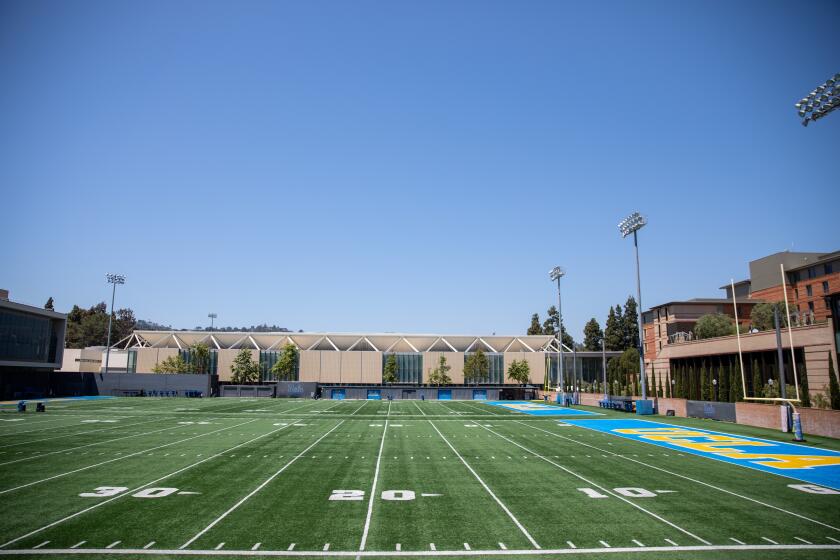This May Be Last UCLA-USC Meet in Coliseum
“The Last Picture Show,” “The Last Tango in Paris,” and perhaps, the Last Track Meet in the Coliseum.
With renovations planned to lower seating to field level and cover the track, today’s meeting between USC and UCLA has the appearance of the end of an era.
It’s believed that the track would be restored only in event of a major competition, such as the Olympic Games, or World Championships.
So today’s meet is historic in that sense. It won’t be remembered, though, as a classic confrontation between the schools.
UCLA is heavily favored, men and women, over USC.
Moreover, some prominent athletes won’t compete, or will be limited to one event because of injuries.
UCLA’s Steve Lewis, the 1988 Olympic 400-meter gold medalist in Seoul, is still bothered by a hamstring injury. USC’s Quincy Watts, the former Taft High standout sprinter, has a strained hamstring, but will anchor the 1,600-meter relay.
USC’s George Porter, who placed third in the 400-meter intermediate hurdles in the 1989 NCAA meet, will run only in that event. Porter has been inactive since having a wart removed from his foot.
Some other athletes are questionable because of injuries, among them UCLA hurdler Derek Knight and long jumper McArthur Anderson. The Bruins, however, have more depth than the Trojans, who most likely wouldn’t win even if they were at full strength.
“We can’t absorb injuries,” USC Coach Ernie Bullard said. “We’ll do the best we can, but we aren’t going to double or triple our people in events. We want to do a good, sound job but if we do things that interfere with our qualifying and not doing well in the NCAA meet, as a coaching staff we’re dumb.”
USC could have an impact at the NCAA meet in June with Watts, Porter, West German long jumper Dietmar Haaf and the relays teams--provided everyone is physically sound.
Bullard is gearing the entire season toward that competition.
Since Bob Larsen became UCLA’s coach in 1985, the Bruins haven’t lost a dual meet, an impressive 45-0-1 record.
Moreover, UCLA has won three consecutive Pacific 10 Conference meets and two of the past three NCAA championships.
There was a time when USC dominated UCLA, winning 33 consecutive meets at the outset of the series, but the Bruins have won the past 11 meets. USC has won only five since 1965. The UCLA women are as dominating as the men.
“Frankly, I think my team is one of the best in the nation and is capable of capturing the national championship if, particularly, our juniors do the job that we recruited them for,” said Bob Kersee, UCLA’s women’s coach.
Track Notes
Field events begin at 11 a.m. with the first running event scheduled for 1 p.m. . . . Former standout athletes from both schools will be in attendance. A legends eight-man 800-meter relay will feature such former Olympic champions as USC’s Don Quarrie and Rex Cawley along with UCLA’s John Smith, the world record-holder in the 440-yard dash, and Olympian Benny Brown. Sid Wing, who will run a leg on the Trojan team, said the Bruins have an unfair advantage with an aggregate age of 352 years to 394.
Dietmar Haaf, the European indoor long jump champion, says a dual meet is a new experience for him. “In Germany I competed for national and club teams,” he said. “We had no special names like Trojans and Bruins.” . . . Bud Houser, 88, who is believed to be the oldest living track and field gold medalist, will be at the meet. The former USC athlete won the shotput and discus in the 1924 Olympics, then got another gold medal in the discus in 1928.
The USC men lead UCLA, 38-18, in the series, and the Bruin women have won four of six meetings with the Trojans. The UCLA women have an 18-meet winning streak, having last lost in 1987, to USC.
Go beyond the scoreboard
Get the latest on L.A.'s teams in the daily Sports Report newsletter.
You may occasionally receive promotional content from the Los Angeles Times.



